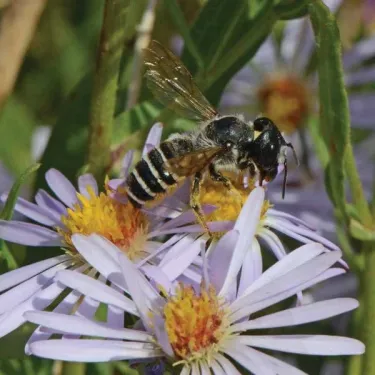
The Bee Counters

Colorado has one of the nation's most diverse bee fauna. An army of volunteers is helping CU scientists track hundreds of front range species.
When a phenomenon called colony collapse disorder began ravaging honey bee populations in the mid-2000s, the world took notice: Flowers, food crops and ecosystems depend on bee pollination.
Of late, mass colony collapse has moderated in the United States, but honey bees’ long-term population trend is still sharply downward. And there are thousands of other bee species about which little is known because they get less attention. Colorado alone is home to 946 species, more than all but four other states.
Their circumstances are not assumed to be good, based on existing surveys.
“In general, bee populations are considered to be in decline everywhere,” says Virginia Scott, entomology collections manager at the University of Colorado Museum of Natural History in Boulder.
To learn more about Colorado’s abundant solitary wood nesting bees, which make up about 25 percent of all Front Range species — and to lay a foundation for scientific assessments of population changes — Scott and colleague Alexandra Rose in 2013 established The Bees’ Needs, a research project involving hundreds of volunteer “citizen scientists.”
“We want to understand the ‘other’ bee mystery,” says Rose, a bird biologist who is the museum’s program manager for citizen science.
Counting bees isn’t easy: Small and spry, they can live throughout a vast area.
“Some are the size of gnats,” says Rose.
“You’d think they were fruit flies.”
Also, the Front Range is home to a great diversity of bees, about 650 species, or more than two-thirds of all Colorado species. (Only the desert states of California, Arizona, New Mexico and Utah have more.) Learning something about them all requires a small army.
The Bees’ Needs’ volunteers — 528 in 2014, up from 337 a year earlier — don’t need advanced science training. Mainly, Scott says, they need to be diligent observers and recorders.
“I suppose patience helps, too,” she says.
A goal of The Bees’ Needs is establishing baseline populations for as many species as possible.
These will provide a basis for comparison in the future.
To make data collection convenient, the museum provides volunteers with nesting boxes similar to birdhouses — stationary attractions where bees (and wasps) take shelter and deposit identifying traces.
The first year of the program, Rose, Scott and friends drilled 10,000 holes of varying sizes into each of 250 wooden boxes.
Volunteers install the boxes in sunny spots (shady ones attract earwigs) and track nests bees build there, noting the plugs mother bees put into the holes to protect their larvae. Different species use different plug materials — resin, for example, or chewed leaves, grass, mud or silk. Volunteers check the nests every two weeks from April to October, taking pictures and reporting on nest materials.
Adult bees die after the first hard frost. In the spring, offspring chew through the plugs to enter the world outside.
“It’s fun, especially as you get others involved,” says volunteer Sandra Laursen, a researcher in CU’s ethnography & evaluation research unit.
Last year Laursen hung her nesting box on the fence of her Boulder condominium complex and found that the box’s “apartments” especially appealed to children.
“One ten-year-old boy quite liked it when he had spotted something I hadn’t,” she says.
So far, nobody’s been stung (or said so, anyway), according to Rose — not even by the wasps that also take advantage of the boxes for nesting.
Wasps engender less fondness than bees — “We discovered early on that wasp is a four-letter word,” says Scott — but they too are important pollinators. Solitary wasps harvest aphids, caterpillars and other garden pests. Rose calls them “the unsung heroes of the gardening world,” noting they pollinate flowers along the way: “Talk about organic gardening!”
Rose soon expects to finish analyzing the citizen scientists’ 2013 data sets. This will yield initial baseline populations for many Colorado bee and wasp species. Data sets collected in the years ahead will help reveal population changes.
“This is a long-term project,” Scott says. “The more cumulative data we can collect, the more we’ll understand the mysteries of these solitary insects.”
To volunteer for the 2015 Bees’ Needs project, visit beesneeds.colorado.edu/.
Photo courtesy CU Museum of Natural HIstory (bee); Diane Wilson (bees on flowers)
Colorado Bees: A Sampler

Common name: Cuckoo leaf-cutting bee
Scientific name: Coelioxys sp.
Looks like: White stripes, pointy abdomen
Size: 1/2″

Common name: Mason bee
Scientific name: Hoplitis albifrons
Looks like: Jet black, elongate, patches of pale hairs
Size: 5/8″

Common name: Green mason bee
Scientific name: Hoplitis fulgida
Looks like: Bright metallic green or blue-green, elongate
Size: 1/2″

Common name: Masked bee
Scientific name: Hylaeus leptochepalus
Looks like: Shiny, black, nearly hairless with ivory marking on face, legs
Size: 1/4″

Common name: Leaf-cutting bee
Scientific name: Megachile sp.
Looks like: Fuzzy
Size: 5/8″

Common name: Pugnacious leaf-cutting bee
Scientific name: Megachile Pugnata
Looks like: Gray, large-head, white stripes on elongate abdomen
Size: 3/4″

Common name: Mason bee
Scientific name: Osmia sp.
Looks like: A fly; rotund, metallic blue
Size: 3/8″

Common name: Cuckoo bee
Scientific name: Stelis rudbeckiarum
Looks like: A stocky wasp, bald, black with yellow stripes
Size: 5/16″

